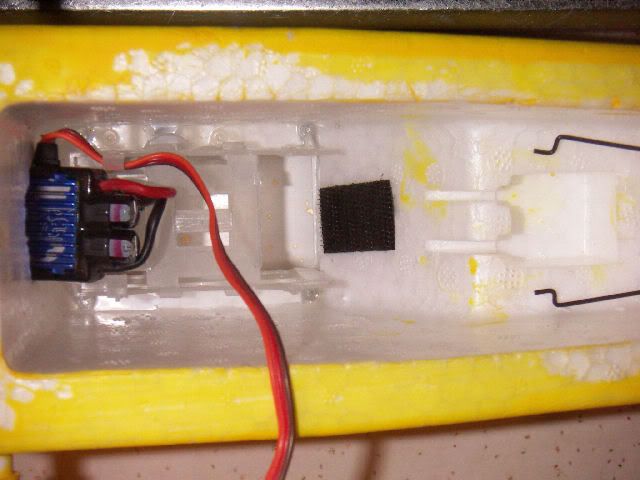|
|
Post by flydiver on Apr 1, 2009 20:50:59 GMT 1
LVC with jumper removed is 8.8-8.9v. If you want to maximize your lipo life I'd suggest not flying to LVC as the lipo will be about dead. Best to leave 20% capacity left. That translates to about 3.7v/cell RESTING voltage. I use Castle Creations ESC a lot and tune LVC (working) to 3.3v/cell. Even then I seldom fly to LVC.
To do this you fly by TIME. How much time depends on your style, lipo size, prop and a host of other factors (wind, motor wear, etc.) so there is no exact formula. Fly >check >fly more >check again, until you figure it out. More capacity is better than less. It is NOT NiMh. You DO NOT want to take it down too far. Over discharge is one of the main culprits in short lipo life.
Once you go to brushless and other ESC pay attention to the LVC and method they use. Several well known brands have lousy LVC (I won't mention GWS and Electrifly as that would be too revealing).
|
|
|
|
Post by patmatgal on Apr 1, 2009 22:32:25 GMT 1
gallagher04401
I took out the whole battery box, cut off the entire back wall then put a hook strip of velcro on the angled part of the fuse (right behind battery box) then re cemented the thing back. Put a loop strip on each battery and you're ready to go. The battery box can take more abuse and as long as the width and height of the battery let it fit thru the new opening even a 2200 mah battery fits & doesn't knock the servos.
|
|
|
|
Post by gagallagher04401 on Apr 1, 2009 23:29:39 GMT 1
Hey patmatgal How about some pics? I would like to have this all done before my stuff gets here (I hope by Saturday!)and I do not want to screw it up. Back wall of radio box, end towards the tail I asume? What did you have to do with the receiver? Pics would be awesome  PS- WHAT IS THE PLUG IN THE MIDDLE, TOP OF THE RX? it runs down to a little mounted circuit board plug on the side of fuse by the battery door? i'd like to take it out if I do not need it. Thanks George |
|
|
|
Post by duck9191 on Apr 2, 2009 6:43:25 GMT 1
thats for the xport thing for stuff like the drop and combat modual.
|
|
|
|
Post by gagallagher04401 on Apr 2, 2009 12:34:40 GMT 1
So in other words it can be eliminated
|
|
|
|
Post by patmatgal on Apr 2, 2009 13:49:17 GMT 1
gallagher04401 Yeah, can be unplugged and taken out for good (one less wire to get in the way). This is one of the few pics taken during a build, get so caught up in it that I forget to take pics.  You can see that the ESC is about 2/3 the way in a little tunnel I cut out, and the little rectangle of velcro on the angled behind the battery box. No pics of the battery box out of the fuse but it's pretty straight forward: take it out, clean off as much of the white silicone adhesive as you can, cut off the back 1/3 of the top and the whole back wall and then put it back together using your own glue (a little Gorilla Glue goes a long way). |
|
|
|
Post by gagallagher04401 on Apr 2, 2009 14:20:49 GMT 1
I will be using the stock Rx/ESC, silde that forward some, snip up the batt box for battery to slip through. put a piece of velcro on the battery? and on the angled part of the fuse to hold the battery in place. Am I understanding LOL  Thanks Pat! George |
|
|
|
Post by gagallagher04401 on Apr 2, 2009 14:24:30 GMT 1
I know one thing after looking over the receiver etc.. I will e happy when I can afford to upgrade radio equip/Rx/ESC the stock Rx looks like something you could get out of a cereal box!.
If anyone has a stock Channel 1 rx they would like to get rid of cheap or even give away I would not mind having a spare on hand, just because it seems so cheap.
Thanks
George
|
|
|
|
Post by patmatgal on Apr 2, 2009 15:38:42 GMT 1
Yes, that's right, except that I didn't realize that you would be using the stock receiver. I'm not sure if you'll be able to move the ESC/receiver far enough forward for battery clearance, if not just snap the ESC/receiver out of the top of the battery box and tape it to the right side of the fuse (wires for battery will be pointing down and you'll have plenty of room with the ACT and X port wires removed)
|
|
|
|
Post by gagallagher04401 on Apr 2, 2009 17:24:18 GMT 1
Anyone using 25 or 30C batteries in there cub with stock motor, & Rx/ESC? Or anymore then 20C to much for stock electronics?
Also anyone know the stock Rx/ESC max Amp rating?
Thanks
George
|
|
|
|
Post by gagallagher04401 on Apr 2, 2009 18:07:50 GMT 1
Well I have been reading more about Lipo's and I am hearing more horror stories then I am good one about dangers. Well to be honest it has me a little scared/worried. LOL
I have narrowed it to this, help me if I am wrong or missing anything
1. charge is lipo sack, pot, something fire proof
2. Do not over charge
3. Do not run below LVC (what is that on a stock electronics cub with Rhino 3S 20C 1550mah packs) or how do I figure it out?
4. make sure each of the 3 cells in the battery are balanced at the same voltage (my charger should tell me this though correct?)
What do you all store your batteries in when not using them? Do you keep them in your house?
Thanks
George
|
|
|
|
Post by duck9191 on Apr 2, 2009 18:57:39 GMT 1
the battery will only deliver as much current as the motor needs, so you can run any size battery you want as long as it can supply at least wat the motor needs.
lipos are more dangerous then nickle chemistry batterys but still most failurs are from user error. one bigthing is to make sure that your charger is set to the correct cell count, or you will over charge the battery and it will likely catch fire. also don't charge at over 1C. don't use them if they are damaged, they maystill work but will degrade over time from oxidization.
I have about 15 lipo packs in all sizes and haven't had an issue yet, there is probably about 60 lipos in our group and no one has had issue but it does happen, just be carefull and make sure everything is set correctly and you should have no problem.
|
|
|
|
Post by gagallagher04401 on Apr 2, 2009 20:36:16 GMT 1
Ok. so my batts I will be getting are 3S make sure my charger is set for 3S (3 cells?)
So I can run any 3S, mah amount, 20C, 25C, etc.. battery I want? ( As long as it fits in the plane, etc...) I want to make sure I under stand this fully.
Thanks
George
|
|
|
|
Post by flydiver on Apr 2, 2009 22:15:52 GMT 1
C-rating is what the peak amp capability of the battery is. In general higher C-rated batteries will be a bit heavier and somewhat to considerably more expensive.
Multiply the amp size x the C-rating to get the output capability.
2200mA (2.2amps) x 20C = 44Amp capability output.
If you are using the stock motor you won't be exceeding 20A (shouldn't really be going past 15A a battery like the example above is way more than you need.
OTOH if you had a Stryker with a hopped up motor in it that took the same size battery (to balance) you might want the extra C-rating for that motor. Extra rating (like extra mA) won't hurt a motor, only your pocket book.
To make that clear - C-rating or mA rating per se does NOT determine power output on a system, but if undersized can limit the power capability.
Power output is almost totally defined by the motor and the prop. The ESC has to be large enough to hand the power demand and the battery have enough capacity (combination of the mA and C-rating) to deliver. If the battery is undersized or a very low rating it will starve the motor and since the demand is excessive for the battery design will likely be damaged.
So if you get a 1000ma lipo with a 10C rating it will put out:
1.0A x 10 = 10A.
If you put a 12x6 SF prop on a stock system it will likely try to pull about 25A (maybe more). Neither the battery, motor, or the stock ESC are designed to take that. It'll be a race to see what fails first.
Your first 30 seconds of flight excitement will only be exceeded by your shock when the whole system croaks abruptly in the air.
This kind of mistake happens all the time.
I make it a policy to derate C-ratings by 20%. Some folks just consider the Peak rating to be the Continuous rating and ignore the 'phoney' peak rating.
Setting a charger is somewhat charger specific. The Cellpro is not the same as the Turnigy or the Hextronic or the Parkzone. RTFM.
|
|
|
|
Post by patmatgal on Apr 3, 2009 1:07:32 GMT 1
Like duck said, most failures are from user error, just be overly cautious and things will be fine. Here's a link to a comparison of a Cellpro to the Accucel (think I read somewhere that you had ordered an Accucel?)  I have a Cellpro 4 (and love it, thanks again fly), will do just about everything except make a cup of coffee and the new Cellpro Multi will probably do that. One thing it won't do is overcharge the battery. Have not used an Accucel so don't have 1st hand experience with it but a lot of people debate over Cellpro or Accucel-6 (my vote is for the Cellpro from FMA Direct at www.fmadirect.com/index.htm ) The LVC as I recall it is around 8.9 volts, too low in my opinion because by then the battery has sustained damage. I use one of these www.hobbycity.com/hobbycity/store/uh_viewItem.asp?idProduct=6589 to tell me the volts in the battery after flying and as long as I don't have to put more than 75% of the mah back in I'm a happy camper. Just be safe, do a ton or reading (these 2 other sites are good www.wattflyer.com/forums/index.php?and www.rcgroups.com/batteries-and-chargers-129/ ) about safely handling Li Po batteries and you'll be good to go. PS I just store my batteries in a cool dry place (in a broiling pan) |
|